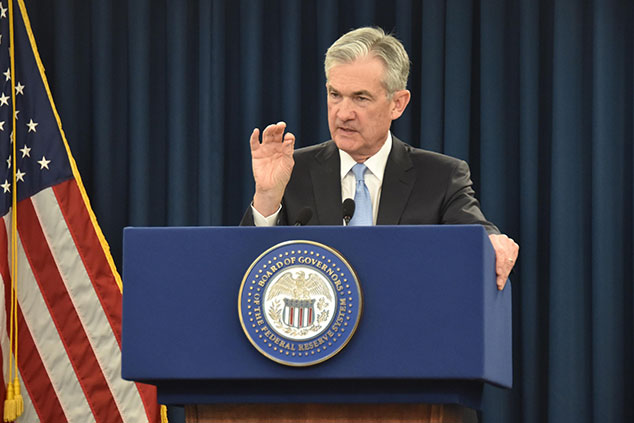
This article is taken from our FREE daily investment email Money Morning.
Every day, MoneyWeek’s executive editor John Stepek and guest contributors explain how current economic and political developments are affecting the markets and your wealth, and give you pointers on how you can profit.
A couple of months ago, everyone was panicking about impending recessions and inverted yield curves.
Now the US has just reported much-stronger-than-expected growth for the first quarter of the year.
Will that make anyone change their minds?
Not a bit of it. If anything, the calls for America’s central bank, the Federal Reserve, to cut interest rates have grown even louder.
Why’s that?
No one wants tighter monetary policy, especially not politicians
Later this week, the Federal Reserve will meet up to discuss what it should do next with monetary policy. It might be a tricky discussion.
You see, it’s pretty clear now that Fed boss Jerome Powell is well on the way to being a true convert to the Greenspan gospels (commandment number one: Thou shalt not allow the S&P 500 to fall by 20%). Powell admitted it earlier this year, with the Fed’s epic U-turn on interest rates, which has helped to power the world’s financial assets to a record-breaking start to the year.
Meanwhile, Donald Trump has been calling for the Fed to do even more. Indeed, he’s even called for more money printing – quantitative easing (QE). Earlier this month he said: “I think they should drop rates and get rid of quantitative tightening. You would see a rocket ship” – presumably he’s referring to the US economy there.
This should come as no surprise. Trump’s business background is in property, and you wouldn’t expect a property guy to be anything other than a fan of low interest rates. Property is all about debt, after all.
That said, it seems harsh to single Trump out. I can’t imagine there are many lobbyists for higher interest rates out there among the asset-owning classes. And to be fair, I haven’t seen many other past presidents crying out for higher interest rates during their terms in office either. Trump just happens to be in the hot seat during what should be a rate-rising cycle.
And he’s hardly the only person saying we should print more money – that’s exactly what the advocates of Modern Monetary Theory (MMT) getting lots of press for the Democrats are calling out for as well. Make no mistake – everyone wants easy money, which is one reason that it’s so hard to hold out as Fed boss.
Anyway. The trouble for Trump (and for Powell, more pertinently) is that the latest US GDP figures were a lot better than expected. US economic output grew at a rate of 3.2% in the first quarter, versus expectations for 2% growth.
That is pretty impressive, given that a couple of months ago people couldn’t stop talking about the “shutdown”. And you’d think it might make the Fed start to wonder whether the economy is fragile enough to justify scrapping all rate rises for the year ahead.
There are many excuses for the Fed to be dovish
The good news for the Fed is that there are plenty of excuses it can make if it wants to keep the market’s hopes alive. The Fed’s key interest rate is sitting at a level of 2.25% to 2.5% right now and it certainly won’t be rising this week, I can tell you that.
Firstly, even if economic growth is doing OK, there are plenty of holes that can be picked in the report. There are always holes that can be picked in these reports, but the eagerness to do so in the mainstream press shows that the Fed will be pushing at an open door if it decides to be even more cautious this week.
For example, a lot of the growth was based on “stockpiling” – companies building up inventories due to fears of trade disruption. Underlying domestic demand grew by just 1.3% versus 2.6% the previous quarter. Meanwhile, inflation rose at an annualised rate of just 1.3%, which is well below the Fed’s target of 2%.
Secondly, and perhaps more importantly, there’s the issue of the strong US dollar. Powell knows as well as anyone else does that a strong American currency is bad news for rising markets. An emerging market crisis would not go down well with US investors. They might be willing to ride it out, but not so much if the earnings of US-listed stocks which sell lots of goods overseas get hammered too.
You’ve also got members of the Fed board saying that they might be as well to take out some “insurance cuts” just for the sake of it. That’s a point made by Fed vice-chair Richard Clarida, notes the FT.
Clarida pointed out that the Fed did this in both 1995 and 1998. Clarida presumably doesn’t think that this overly-precautionary monetary policy had anything to do with the rampant tech bubble and bust that ended the 1990s.
Anyway – don’t be surprised if the Fed sounds even more nervous at its next meeting than it did at the last. And don’t be surprised if an earlier end to quantitative tightening is hinted at. I suspect they’ll want to head the strong dollar off as quickly as possible.
If not, the eventual market reaction will force the issue further down the line.
In terms of your own portfolio – stick to your plan, give a bit of thought to taking some profits from overseas investments and bringing them back to sterling assets (if relevant), and have a bit of gold for when a dovish Fed and inflationary pressure finally start to convince people of the value of the yellow metal.
Oh, and subscribe to MoneyWeek if you don’t already – here’s where to get your first six issues free.